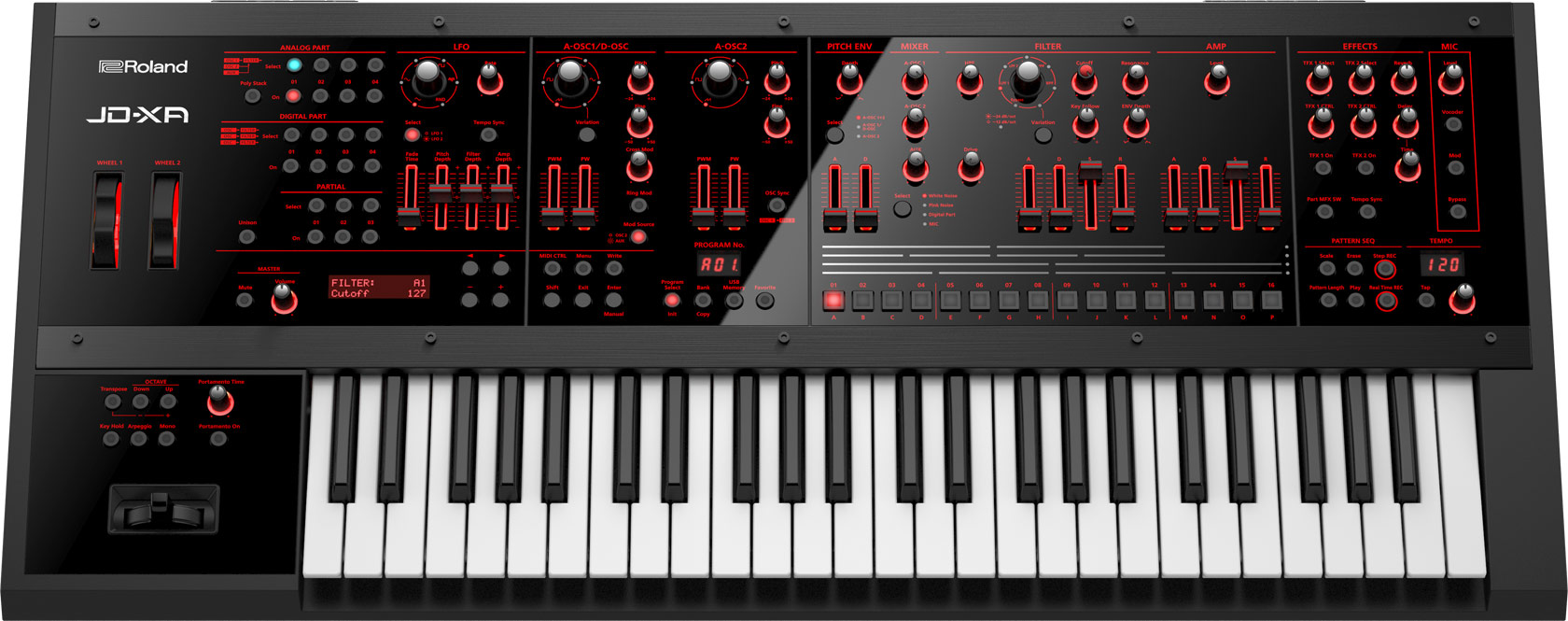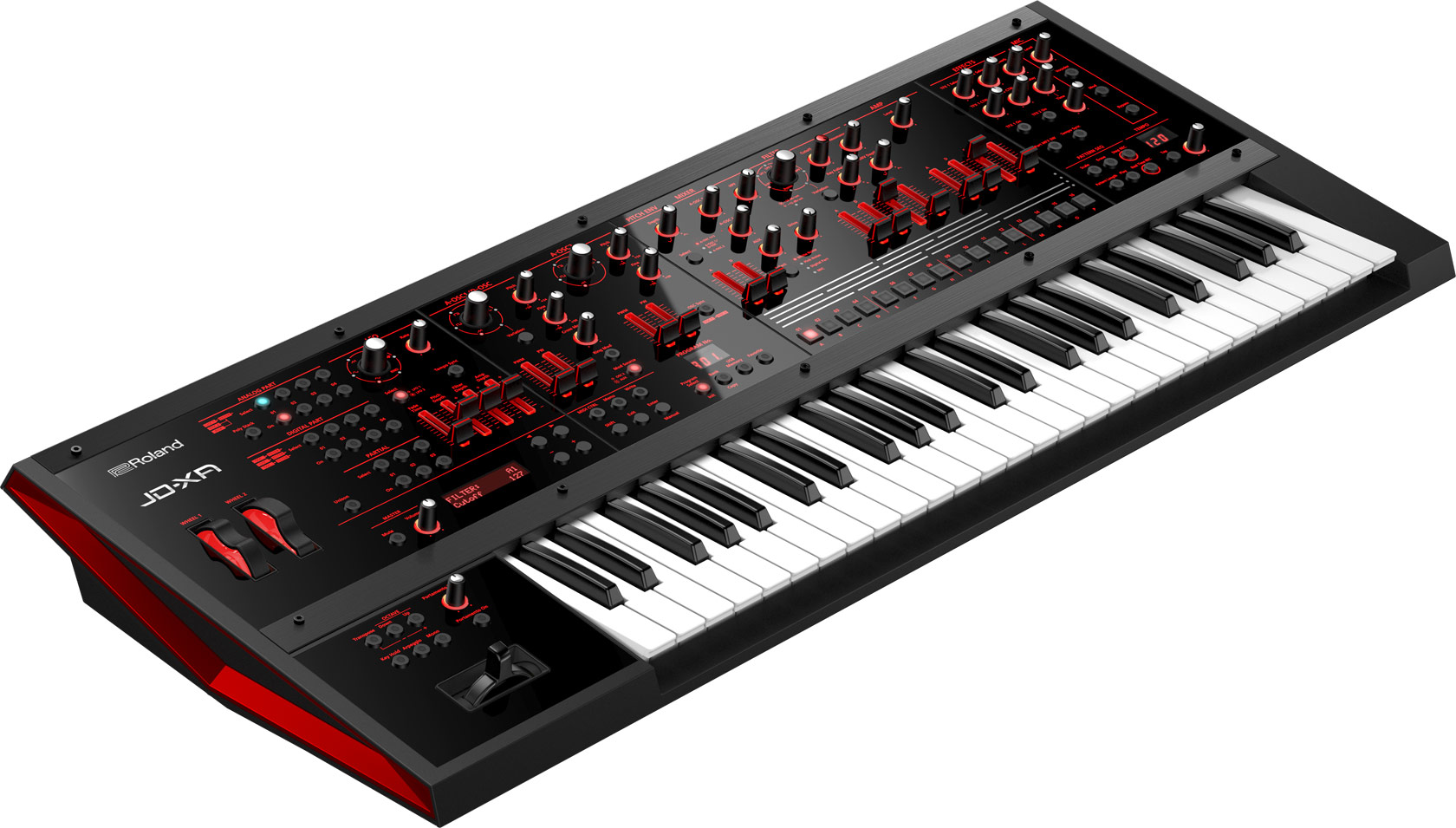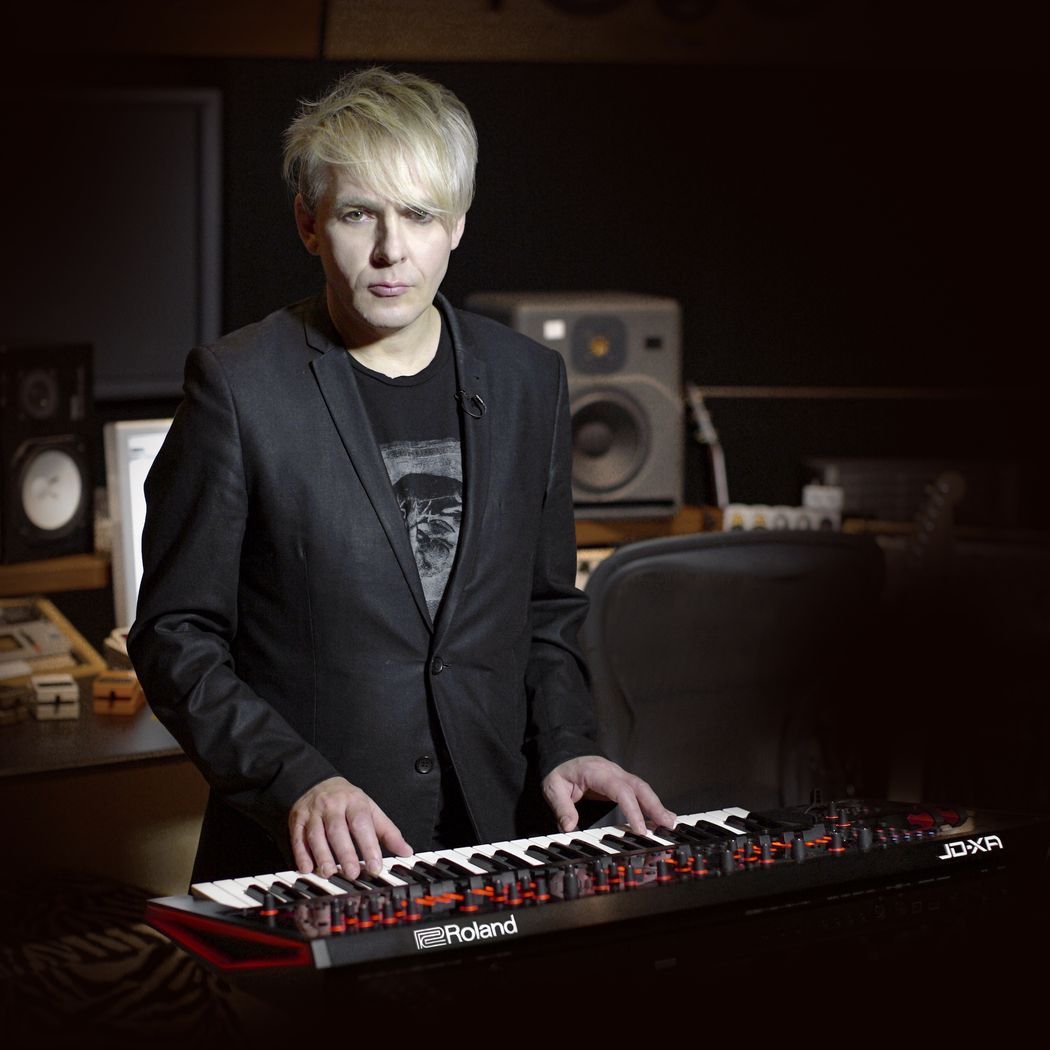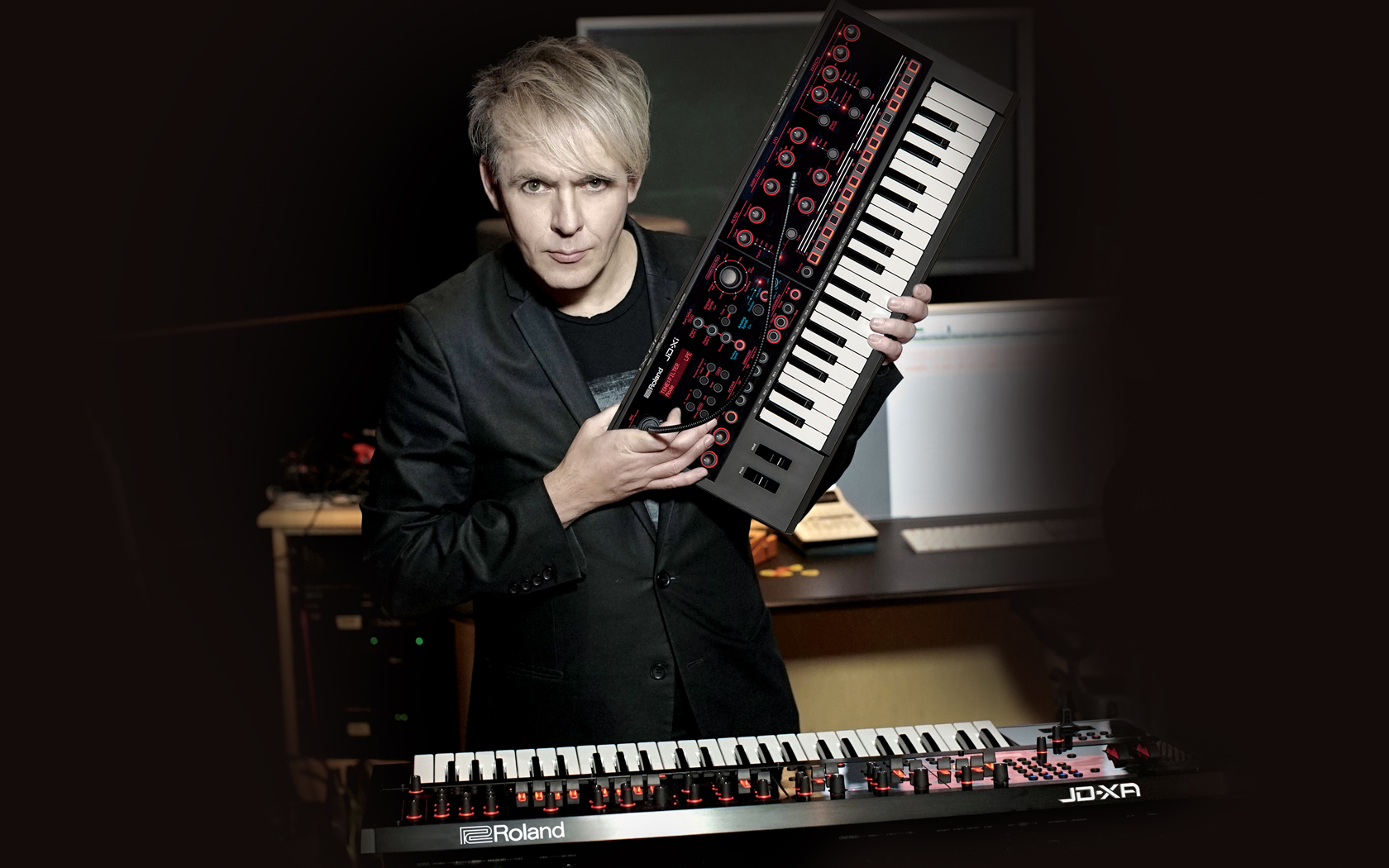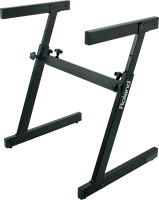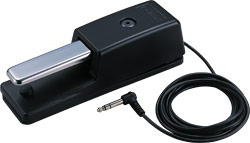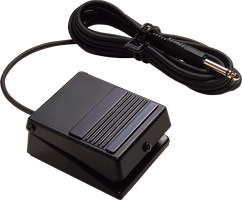Analog. Digital. Magical.
The JD-XA is a unique crossover synth that brings together analog warmth and digital versatility in one super-creative, no- compromise instrument. First, there’s a four-part, all-analog monster with true analog filters and a direct dry output. Next up is a four-part digital engine powered by Roland’s SuperNATURAL synth technology, plus an impressive selection of potent effects. The JD-XA’s engines can be used independently or interactively, providing an incredibly flexible platform for sound design, studio work, and live performance. Use the analog and digital parts side by side, stack them up for total sonic devastation, or shape digital waveforms via the analog filters to create sounds never heard before. With the JD-XA, you can forget about analog or digital—just close your eyes, imagine how the future sounds, and start creating music.
Standard Features
- Advanced synthesizer with independent analog and digital sound engines
- Discrete analog synth engine (four parts) with 2 x OSC, Filter, Amp, 4 x Env (2 x Pitch, Filter, Amp), and 2 x LFO per voice plus Analog Dry Out for raw signal output
- Analog filter section features 4-Pole, transistor-ladder, and multi-mode (LPF/HPF/BPF) filters with supremely smooth, natural response to knob movements
- OSC section includes Cross Mod, Ring Mod, and OSC Sync, all of which can be used simultaneously
- LFO rate covers a wide range from ultra-slow to ultra-fast
- Incredibly fast attack envelope time
- Separate digital section built around SuperNATURAL synth engine (four parts, 64 voices) that’s compatible with INTEGRA-7 sound libraries from Roland’s online Axial sound portal
- Digital parts can be routed through the analog filter section for warm, organic results
- Comprehensive effects with MFX for all parts plus five system effects (Reverb, TFX1, TFX2, Delay, and Master EQ)
- Flexible routing options for highly creative sound design
- Intuitive 16-track pattern sequencer (8 tracks for internal parts, 8 tracks for external parts) for fast creation of songs and loops
- Onboard USB, MIDI, and CV/GATE interfaces plus flexible MIDI control functionality make the JD-XA the ideal centerpiece for live performance and music production
- Mic input allows you to modulate synth sounds with your voice and explore classic Vocoder functionality
- Plenty of backlit knobs, sliders, and controllers for hands-on sound shaping


The Analog Engine
Each of the JD-XA’s four analog parts has two oscillators, along with filter and amp sections and four envelopes—all with incredibly fast attack and response times. You also get two LFOs, with super-smooth coverage from ultra-slow to ultra-fast. Start by creating your sound from scratch, or configure the JD-XA as an eight-oscillator, pure analog version of the legendary Supersaw waveform. Or invoke the power of Poly Stack mode for warm, organic four-note chords that will sweep you away. Once you’ve got that killer analog sound, you can route it directly to the analog dry output or send it to the onboard digital effects for further experiments in the art of sound design.

The Digital Engine
The JD-XA doesn’t just do classic analog—it’s also equipped with a completely separate four-part, 64-voice digital sound engine powered by Roland’s acclaimed SuperNATURAL synthesizer technology. This lets you play some of the most expressive and natural sounds available anywhere, as the JD-XA is compatible with the synth engine from the INTEGRA-7 sound module, a firm favorite of top producers, composers, and sound designers. And if you need some extra inspiration, visit Roland’s online Axial community and download the latest creations from high-end programmers to tap into great sounds for a wide variety of genres.

Analog and Digital Working Together
With its distinctive crossover design, the JD-XA is very unique in its approach to synthesis. You can blend the engines together if you want, but you can also use them completely independently, truly giving you two synths in one. Additionally, the analog and digital engines are able to interact in many creative ways. For example, digital sounds can be routed through the analog filters, or used as modulation sources for the Cross Mod and Ring Mod functions in the analog section. If you’ve got big ideas when it comes to sound design, you need a powerful and flexible synth, and the JD-XA really delivers.

Smooth, Warm Analog Filters
The filters in the JD-XA’s analog section are 100-percent analog, giving you smooth, warm sound and organic response. There’s the classic 4-pole, a transistor ladder with stronger characteristics, and a multi-mode filter option for the essential LPF, HPF, and BPF duties. Thanks to an all-new circuit design, the resonance of the multi-mode filter provides a uniquely aggressive sound character that’s really cool. And because the filters are completely analog, you get a supremely smooth slope as you twist the knobs, with no stepping or unwanted artifacts.

ANALOG DRY OUTPUT

Powerful Effects for Every Occasion
When it comes to effects, the JD-XA is well equipped to handle any sound shaping you want to apply. Each analog and digital part is equipped with a powerful and versatile MFX processor that offers 67 different effect types, including high-impact processing options like Bit Crusher. The essentials are also covered via the five system effects processors, which provide reverb, delay, and master EQ plus two TFX processors with 29 effect types each.

16-Track Pattern Sequencer with
Real-Time and Step Recording
With all this sonic power at hand, you’ll want to dive in and start making music straight away. To get your creativity flowing, the JD-XA has a comprehensive 16-track pattern sequencer with 8 tracks for internal parts and 8 tracks for external sources, allowing you to build sequences and loops quickly and intuitively. Use real-time recording mode to lay down parts in a familiar linear fashion, or step recording mode to create in the old-school pattern style. However you like to work, this sequencer is designed to keep you connected to your music—the JD-XA is all about inspiration, not interruption.

Powerful, Flexible Routing and
Hands-On Control
Power is nothing without control, so the JD-XA’s interface is built around harnessing the potential of its remarkable sound engines. The velocity-sensitive keyboard supports aftertouch, and you have plenty of backlit sliders, knobs, and wheel controllers to shape the sound. There are unprecedented routing options as well, thanks to a flexible system that lets you route a single mod source to four destinations. In addition, you’re able to control external modules or DAW plug-ins via MIDI, USB, and CV/GATE, making this a synth that can sit at the heart of any live or studio setup. If you can imagine it, you can probably do it on the JD-XA.

Versatile Mic-Controlled Modulation
and Onboard Vocoder
The JD-XA’s mic input brings an extra dimension to your music. For starters, you can use the mic as a modulation source, controlling filter cutoff, Cross Mod, or other parameters with your voice. Alternatively, you can dial up Vocoder tones, or simply add some pro-grade vocal reverb via the mic’s dedicated reverb processor. Whether you want to speak, sing, or synthesize, plugging a mic into the JD-XA is sure to lead to some positive musical mayhem.
- •
- •
- •
- •
- •
- •
- •
- •
- •

USB Interface and CV/GATE Outs for Controlling Analog Gear
The JD-XA features a built-in USB audio/MIDI interface for working seamlessly with your favorite DAW. It’s also equipped with two CV/GATE outputs, making it easy to interface with popular CV/GATE instruments. Your analog or modular synths can be controlled directly from the JD-XA’s keyboard or pattern sequencer, or from the comfort of your DAW when the JD-XA is integrated into your computer music production environment via USB.






- •
- •
- •
- •
- •
- •
- <
- >
Crossing Over
JD-XA The Best of Both Worlds: Combining Digital and Analog Sound












